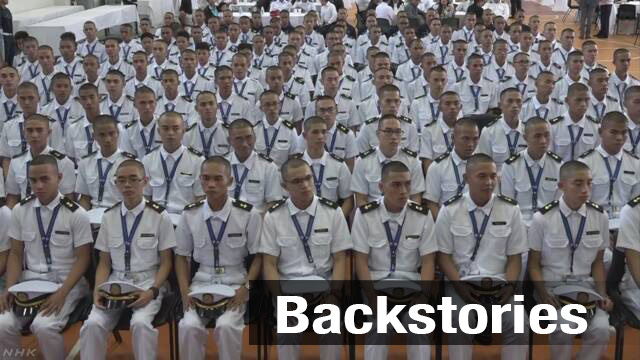You are here
Filipino Seafarers in Hot Demand
Filipino Sailors in Hot Demand
Masashi Yamaguchi October 31, 2018 https://www3.nhk.or.jp/nhkworld/nhknewsline/backstories/filipinosailors/
Demand for maritime transportation has recovered after a huge plunge following the Lehman Crisis. There are currently about 110,000 cargo ships -- the most ever -- in operation across the world. But the industry is facing a shortage in sailors, and shipping firms are battling for the available skilled maritime personnel.
One of the places at the center of this competition for sailors is the Philippines, considered one of the best sources for top shipping talent. NHK Manila Bureau Chief Masashi Yamaguchi reports.
Filipino crew on a Japanese carrier
In September, I had the chance to sail aboard Mitsui O.S.K. Lines' car carrier AZALEA ACE. With the ability to carry 3,000 vehicles at once, the ship plays a big role in transporting one of Japan's main exports. But I didn't meet a single Japanese crewmember onboard.
The ship had 22 sailors, all from the Philippines. The crew is in charge of all of the ship's operations, including navigation, maintenance, managing the cars the ship carries, and even cooking.
During my stay, I was impressed by how thorough the crewmembers were with their work. For example, to ensure that none of the cars were damaged, they had to navigate the ship without letting it tilt.
Europeans partnering with sailor training centers
Shipping companies across the world are lining up to secure the services of highly-skilled sailors from the Philippines. At the front of the queue are European firms, especially from Norway, Denmark, and Germany.
Many maritime training schools in the Philippines have partnerships with European companies. These firms predicted the decline in sailors as a result of their countries' aging and shrinking populations, and the ensuing competition for overseas talent. To prepare, they started making ties with local academies in the Philippines as early as 30 years ago.
John B. Lacson Foundation Maritime University is the country's biggest seafarer academy. I was allowed to sit in on one of the university's board meetings. I was surprised to see executives from Norwegian and German companies in attendance. They were checking on the school's administrative principles, curriculums, and even certain students' academic records. Each of these companies offers a scholarship to outstanding students. On top of tuition fees, these students are guaranteed employment upon graduation. There are 16 academies in the Philippines that have similar ties with European shipping firms.
Some foreign governments have also begun forging ties with academies to secure the work of sailors. In 2014, the Belgium maritime authority began issuing professional certificates to graduates of a Filipino maritime academy. The certificate is hugely important for advancing in the shipping world, considered a prerequisite to becoming a skipper or mate. And a Belgian license qualifies one to work for vessels operating under all other European flags.
Japanese shipping firms open academies
Japanese shipping firms have been dealing with the sailor shortage through trial and error. They tried automating some of the workloads, and having Japanese skippers and mates work with foreign crews. But it is only in recent years that they have turned their gaze to Filipino sailors, much later than their European competitors.
In 2007, Nippon Yusen became the first Japanese company to open its own academy in the Philippines. Mitsui O.S.K. Lines followed suit this September.
I visited Mitsui O.S.K. Lines' academy in Dasmarinas, outside of Manila. Construction was made possible by a 6 billion yen, or US$5.3 million, investment. The campus is equipped with the latest technology, including an operation simulation module in which students can practice under various weather and traffic conditions. The module uses data collected on weather conditions, port locations, and geography. The facility contains a 3-story-sized container ship engine that students use as part of their training.
The academy's 300 students were selected out of 30,000 applicants. They all have guaranteed employment after graduation, with a monthly salary of US$3,000 -- about 8.2 times given to the average university graduate in the country.
Difference between Japanese and European academies
While European companies are securing talent through partnerships with local academies, Japanese companies are investing in establishing their own schools. What's behind the different approaches?
Japanese companies operate a large number of liquid natural gas carriers and oil tankers. Operating these vessels requires high-level knowledge and skills. Even the smallest spark could cause serious explosions. An accident could mean the loss of a tanker worth 100 million dollars or more. Combined with the cost of an oil spill cleanup, this would mean huge losses for the shipping company.
As the labor shortage worsens, Japanese companies are now preparing to entrust their tankers to Filipino skippers. The companies open their own schools to ensure that the candidates have all the required skills.
Japan used produce up to 50,000 sailors of its own. But as the cost of labor rises, this number is dwindling. It is now down to 1,700.
As this trend continues, Filipino sailors may assume a key role in the Japanese maritime transport industry not so far in the future.

